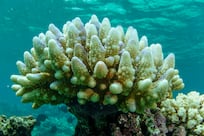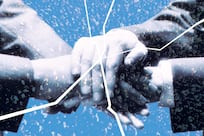Camp Hope sits at the end of a narrow dirt track, 800 kilometres from Santiago, on the upper reaches of Chile's Route 5, a road that starts with the skyscrapers of the capital before giving way first to fields, then forests and finally to desert mountains.
Hope, as it is called by the people who have camped there since early August, is isolated. It is about an hour north from Copiapó, where a daily bus collects families who want to visit the camp, and an hour east of the Bahia Inglesa, the seaside resort where holidaymakers idle away their leisure hours in turquoise waters and on white sandy beaches.
From there, a paved road heads into the desert - a cold and barren stretch of asphalt enlivened, just now, by the blooming of the wildflowers that turn the endless sand into a multicoloured spectacle. Until recently, there was almost no reason for anyone to stop on the desert road between these towns, much less to turn off it.
Now though, police officers stand guard at the end of the narrow dirt track, checking the credentials of visitors - family, media or rescuers - before waving them onwards and into the camp.
Behind them a small collection of tents, canopies, vans and portable toilets has sprung up around the central feature of this makeshift village - the three heavy-duty drills named Plan A, B and C - that have for weeks been burrowing deep underground. Teams of rescue workers swarm around them day and night, struggling to help free the 33 men who have been trapped in the world's most famous gold and copper mine for more than two months.
As the drills go about their work, children play football in their shadows, near a large tent and temporary cafeteria, where the camp's residents and visitors eat free meals prepared by volunteers. Still other kids skip over a rope turned by Rolando Gonzalez, or Rolly the Clown - a miner dressed in a red and yellow patched suit and sporting a red nose. He entertains the children while their parents chat under canopies or check e-mails on laptops connected to the camp-wide free wifi.
On weekdays, about a dozen children attend Hope School, a red portable structure positioned adjacent to the track used by transport lorries. A "children crossing" sign has been placed next to it. Meanwhile, Chilean flags and goodwill messages dot the landscape. Notes have been scribbled onto the boulders that litter the hills and photos of the trapped miners have been pasted on placards. A man leads a prayer service under the shelter of one of the canopies while a cameraman records his every move. Hundreds of journalists are stationed here too, sent by their foreign editors sold on the myriad storylines emerging inside the camp's perimeter - from family feuds simmering between nervous relatives above ground to the men imprisoned below who have somehow sustained themselves for more than two weeks on rations of tuna, biscuits and sips of milk.
Buried under the mountains of "human interest" press about the rescue operation are the sparsely reported issues of poor safety standards and ruthless exploitation of the working class. Indeed, while we have all pored over the exact dimensions of the miners' chamber and reveled in the salacious details of their personal lives (notably the miner reported to have had two women, unaware of one another, praying for him at the site), hardly a word has been written of the miners stranded on the surface. They are also employed by San Esteban Primera and this week marched peacefully in Copiapó campaigning against the non-payment of their wages.
Then there's the story of Gino Cortés, who has taken the company to court because he lost his leg in the San Jose mine in 2009, one of a long list of accidents, some fatal, to occur before the infamous collapse two months ago. While Codelco, the government-run mining company, and other international companies have reasonably high safety standards, smaller operations are known to cut corners. The local press has also been guilty of failing to examine the larger safety issues in Chile, the world's biggest producer of copper, as well as the trapped miners' prospects after the rescue. That, at any rate, is the opinion of Manuel Antonio Garretón, a sociologist at the Universidad de Chile.
"I think the media has given a lot of attention to the problem with the mine," Garretón said. "The problem is the real situation of the miners, how the owners of the mine behaved. All that has not been covered with the same importance. [Reporting] the personal situations, intimate things, is going beyond what I think is appropriate. It is like reality television." The roof of the San Jose gold and copper mine collapsed on August 5. Two days later, another rock-fall blocked an attempt to use a ventilation shaft - which lacked the safety ladder required by law in such areas - to mount a speedy rescue. Pinned back, their escape route effectively shut off, the men took refuge in an emergency shelter 700 metres below ground, a humid two-kilometre stretch of tunnels and caves. They have remained there ever since.
It would take more than two weeks for a percussion drill to make contact with the miners and for Mario Gomez, 63, the oldest of the miners trapped underground, to greet its arrival with his now famous note to the world, written defiantly in red marker: "Estamos bien en el refugio los 33." (All 33 of us are fine in the refuge). Predictably, Sebastián Piñera, the country's president, raced to the scene to be the first to repeat these words to the world's press. Until that moment he had been facing criticism over mine safety standards in Chile, but now he smiled for the cameras.
The country erupted in celebration. In Santiago, people drove through the streets honking their horns, gathered at plazas and waved flags as if they were celebrating a football victory by the national side. A few days later, the government fed five minutes of selected video images to the media. The grainy pictures of the shirtless men showed them looking happy, singing the country's national anthem and chanting "long live Chile".
Piñera has enjoyed a surge in support since the men were found alive. At first he said he hoped they would be freed by Christmas, a timeline that experts said was conservative. That rescue date has since been drastically reduced, first to November and now to October. Earlier this week, Mr Piñera told Chilean radio broadcasters he hoped the men would be rescued before his scheduled trip to Europe on October 15. "I want to share that moment with the miners," he told reporters.
Some families have become suspicious of the government's estimates. Indeed, rumours at the camp suggest that the end to the saga will arrive earlier, that the whole story is being stage-managed by the powers that be. The widespread expectation is that the first men will be pulled to the surface any day now, in a torpedo-shaped capsule emblazoned in the colours of the national flag. Certainly, international media organisations are gearing up for the closing moments of this long-running drama. Earlier this week Eva Salinas, editor of the Santiago Times, an English-language paper based in the capital, told me she had received calls from CNN, an Irish and a Canadian radio station, and a Russian and a Polish TV station in the space of five hours.
"There has been a change in the last couple of days," Ms Salinas said. "Phone calls and e-mail from all over the world are starting to pick up again, which we haven't felt since the first couple of weeks after the men were found alive. We have not seen such sustained interest in a Chilean story before, not even after the earthquake in February," she said. "Political careers can be won and lost on this type of story," said Kelly McBride, an ethics reporting and writing teacher at the Poynter
Institute, a non-profit journalism school in Florida. "The government has a certain liability here because they have a stake in how the mine was inspected". The corollary, McBride explained, was that the government has a stake in controlling the story, an effort that gets easier as it drags on because journalists are happy to have something to report. "Politicians figure this out, too, that any time you keep the reporters happy, they make you look good," she said. "It is an unspoken quid pro quo. Nobody realises that is what they are buying into. The journalists are at best benignly complicit."
"I have read almost everything. A lot of it is fiction," insisted Carola Narvaez, the 36-year-old wife of Raul Bustos. "As a matter of fact, about my husband there are a lot of things that have nothing to do with reality. Usually in the written media, that happens. You say one thing and they write 10 more." Miguel Soffia, a young filmmaker who is shooting a documentary about life at the camp, added: "Some other channels, news departments around the world, they are behaving really bad, like wild dogs running after news."
For his part, Soffia said that showing compassion to the families was something that had come naturally to him. He arrived at the mine when the men hadn't even been found alive yet and considers himself a member of the camp. He hoped his video would ensure that this episode is not forgotten once the breaking-news teams move on. "I think that the documentary is the biggest weapon against forgetfulness," he said. "In about 20 years many people won't remember this right away and something like this could happen again.
"That is one of the main motivations. There is a human history here not getting recognised by the media, you know, so the documentary is for getting all those human experiences." The precedent for this type of rolling news soap-opera was set in 1987, according to Kelly McBride, when an 18-month-old infant named Jessica McClure fell into a well in Texas. CNN was on the scene with round-the-clock TV coverage until the baby was rescued, prompting Ronald Reagan to say "Everybody in America became godfathers and godmothers of Jessica while this was going on."
For McBride, the miner's story presents similar opportunities to news agencies. "This is the type of story that is made for 24-hour news coverage because it is happening in a specific location, you have a lot of characters so you can find the most interesting plots and subplots, it is being drawn out over a long period of time and there is a certain predictability to it," she said. "The people who created reality TV, they are thinking about situations like this. Thinking 'Oh, if we could just have cameras on them all the time and tell this real story.'" And just as on reality television, the stars have their own incentives to play along.
The spotlight is only shining brighter now. The number of people at the site swelled in the early days of October in anticipation of the imminent rescue of the miners. Around a thousand journalists from around the world are expected to watch events unfold from a platform positioned high above the mine and Camp Hope - this despite the fact that the final act of the drama is expected to take two full days to unravel. Once above ground, the men will probably be spirited away from the site, taken immediately to a field hospital, then on to a military base or hospital by helicopter.
Nevertheless, the Japanese national broadcaster NHK will have 15 people at Camp Hope, while the BBC expects to have 20 people working for its various sites and stations. A worker for NBC said recently that 15 people would be on hand to produce for the station, along with its affiliate MSNBC and perhaps even the Weather Channel. A half-dozen documentaries are also in production - including a look at the mechanics of the rescue and a planned HBO programme. There are even rumours of families' signing deals with media outlets for first interviews and exclusives.
"I am sure there are journalists who are paying sources to only talk to them and not other people," said McBride. "Then there are journalists who will treat people very, very well, with dignity and with respect." Alex Fuentes, a freelance photographer who is also working as a producer with Al Jazeera at the mine, said his experience with the families had been good and that they always seemed ready to talk or be interviewed. Some families, he added, seemed to be very aware of the cameras.
"I really think that they are so ready for the media to ask questions," he said. "When something important happens there, as when the drill broke the refuge, I think that most of them are waiting for the cameras to begin a celebration." Meanwhile the miners have become household names, their letters to wives published in local papers. Their celebrity is so assured that Alberto Iturra, the lead psychologist for the miners, has become a media figure himself, and Alejandro Pino, a former radio journalist, is training the miners to remain poised during interviews. They will almost certainly benefit from their fame, assuming they manage it wisely. For their wider communities, the fall-out from the accident could be a good deal more ambiguous.
"The situation they have up at the San Jose mine is one of a kind," said Jenny Yang, a reporter from The Toronto Star in Canada who spent nine days at the mine last month gathering information for a feature. "A lot of people have been flung together in this very, very unique situation. "You do also get the sense some of them will miss it a little bit," she said. "They have made new friends there, lifelong friends, and there is a sense of spirit about the place.
"People aren't just sitting around, reading, distressed. Everyone is making the most of it. They are throwing birthday parties. Life is going on still, in a strange way." But Liliana Ramirez, who has been keeping constant vigil for her trapped husband Mario Gomez, said she would be happy for the ordeal to be over. "We just want it all to end, so we can go home," she said. "I'm going to need a lot of energy when he gets out, because they're going to want to follow us everywhere."
There are more serious worries. Experts predict that the mining company will declare bankruptcy once the ordeal comes to an end. The families of the trapped miners may be able to expect an income of sorts from their celebrity, but colleagues who are left out of the spotlight will struggle. And yet, for the rest of the country the rescue, played out on television and in the papers, has had the effect of raising feelings of unity and nationalism. That's the view of Juan Vergaro Inostroia, a volunteer from the Copiapó municipality who works in the cafeteria and provides assistance to families of the miners when needed.
"For the subconscious of the Chilean people this has been very good news," said Mr Inostroia, a psychologist in the municipality's education department. "It has been good that we can focus, it is something really good for our hearts. It has produced a spirit of solidarity and brotherhood. "At the beginning we didn't know if they were alive or not so our work was more like support," he adds. "Although in the closest circles of the families they always knew they were alive and always had hope."
Hope has sustained those on the ground as they wait for their loved ones to emerge. It is believed that this will be sooner rather than later. What hope is left afterwards, when the world's press decides that the story is over, remains to be seen.
Matthew Chung is a former reporter at The National who now lives and works in Chile.






